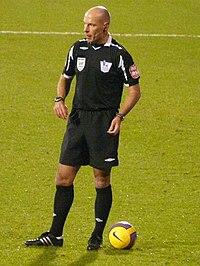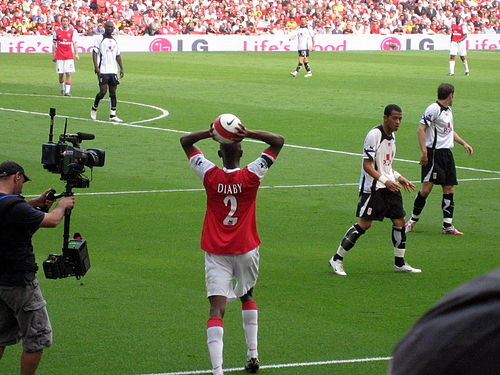| Main page | Categories & Topics | WikiProjects & Things you can do |
The Association football portal

Association football, commonly known as football, or soccer, is a team sport played between two teams of 11 players each, who primarily use their feet to propel a ball around a rectangular field called a pitch. The objective of the game is to score more goals than the opposing team by moving the ball beyond the goal line into a rectangular-framed goal defended by the opposing team. Traditionally, the game has been played over two 45-minute halves, for a total match time of 90 minutes. With an estimated 250 million players active in over 200 countries and territories, it is the world's most popular sport.
The game of association football is played in accordance with the Laws of the Game, a set of rules that has been in effect since 1863 and maintained by the IFAB since 1886. The game is played with a football that is 68–70 cm (27–28 in) in circumference. The two teams compete to get the ball into the other team's goal (between the posts, under the bar, and across the goal line), thereby scoring a goal. When the ball is in play, the players mainly use their feet, but may use any other part of their body, except for their hands or arms, to control, strike, or pass the ball. Only the goalkeepers may use their hands and arms, and only then within the penalty area. The team that has scored more goals at the end of the game is the winner. There are situations where a goal can be disallowed, such as an offside call or a foul in the build-up to the goal. Depending on the format of the competition, an equal number of goals scored may result in a draw being declared, or the game goes into extra time or a penalty shoot-out.
Internationally, association football is governed by FIFA. Under FIFA, there are six continental confederations: AFC, CAF, CONCACAF, CONMEBOL, OFC, and UEFA. Of these confederations, CONMEBOL is the oldest one, being founded in 1916. National associations (e.g. The FA or JFA) are responsible for managing the game in their own countries both professionally and at an amateur level, and coordinating competitions in accordance with the Laws of the Game. The most senior and prestigious international competitions are the FIFA World Cup and the FIFA Women's World Cup. The men's World Cup is the most-viewed sporting event in the world, surpassing the Olympic Games. The two most prestigious competitions in European club football are the UEFA Champions League and the UEFA Women's Champions League, which attract an extensive television audience throughout the world. Since 2009, the final of the men's tournament has been the most-watched annual sporting event in the world. (Full article...)
Selected article
Formed in 2004, the Mariners participate in the A-League, being one of only three teams from New South Wales to play in the competition and the first professional club from the Central Coast to compete.
Despite being considered one of the smaller franchises at the inception of the A-League competition, Central Coast qualified for the first four domestic finals after their establishment. The Mariners had a successful first season, winning the 2005 Pre-Season Cup and losing in the A-League grand final to Sydney FC.
They made the final of the Pre-Season Cup again in 2006 but lost to Adelaide United and finished sixth in the 2006–07 A-League competition at the end of the season. (Full article...)
Selected biography
Larsson amassed 93 caps over 13 years for Sweden, scoring 36 goals. In the summer of 2006 he retired from international football and returned to his home town club of Helsingborgs IF. He later joined Manchester United on a brief loan spell between January and March 2007.
Larsson amassed 93 caps over 13 years for Sweden, scoring 36 goals. In November 2003, the Swedish Football Association bestowed upon him the accolade "greatest Swedish football player of the last 50 years" as part of UEFA's Jubilee celebrations. (Full article...)
Selected association
All India Football Federation (AIFF) is the governing body of football, futsal and beach soccer in India. It is a member of FIFA, and is affiliated with the Asian Football Confederation and South Asian Football Federation.
It is affiliated with the Ministry of Youth Affairs and Sports, Government of India. India men's and women's football teams are governed by the AIFF, and represent India in various international football tournaments. (Full article...)
Did you know (auto-generated) -

- ... that Ryan Roberts, a defensive end for Notre Dame, was a soccer player in high school?
- ... that Ecuadorian footballer Hernán Galíndez won a bicycle for beating a team featuring Lionel Messi when they were children?
- ... that Welsh footballer Jon Morgan went on to become a college principal after retiring?
- ... that Carlton Town F.C., now competing at the eighth tier of the English football pyramid, was once denied promotion by a hat-trick scored by future England international Jamie Vardy?
- ... that goalkeeper Sophie Whitehouse, who has lived in England, Africa and the US, has been chosen to play soccer for the Republic of Ireland?
- ... that after his soccer career, Steve Palacios enlisted in the United States Army and played for the United States Armed Forces soccer team?
Selected image
Selected quote
General images -
Selected World Cup
The 1982 FIFA World Cup was the 12th FIFA World Cup, a quadrennial football tournament for men's senior national teams, and was played in Spain from 13 June to 11 July 1982. The tournament was won by Italy, who defeated West Germany 3–1 in the final held in the Santiago Bernabéu Stadium in the capital, Madrid. It was Italy's third World Cup title, but their first since 1938. The defending champions, Argentina, were eliminated in the second round (finishing third and last in their group). Algeria, Cameroon, Honduras, Kuwait and New Zealand made their first appearances in the finals.
The tournament featured the first penalty shoot-out in World Cup competition. This was the third and last World Cup to feature two rounds of group stages. It was also the third time (after 1934 and 1966) that all four semi-finalists were European. (Full article...)Selected topic
More did you know -
- ... that Swansea City made two appearances at the Millennium Stadium in 2006, winning the Football League Trophy but losing the Football League One play-off Final? (14 March 2021)
- ... that Cheltenham Town lost the 2012 Football League Two play-off Final, their first defeat in nine play-off matches? (6 March 2021)
- ... that despite losing the 1990 Football League Third Division play-off Final, Tranmere Rovers were temporarily promoted to the Second Division? (29 April 2021)
- ... that the year after going into administration, Huddersfield Town gained promotion to the Second Division by winning the 2004 Football League Third Division play-off Final? (27 April 2021)
- ... that Camillo Vaz managed Paris Saint-Germain Féminine when they qualified for the UEFA Women's Champions League for the first time? (1 May 2021)
- ... that Coventry City's winning goal in the 1987 FA Cup Final was an own goal scored in extra time off Gary Mabbutt's knee? (30 January 2021)
Association football portals
More sports portals
Associated Wikimedia
The following Wikimedia Foundation sister projects provide more on this subject:
-
Commons
Free media repository -
Wikibooks
Free textbooks and manuals -
Wikidata
Free knowledge base -
Wikinews
Free-content news -
Wikiquote
Collection of quotations -
Wikisource
Free-content library -
Wikiversity
Free learning tools -
Wiktionary
Dictionary and thesaurus







































